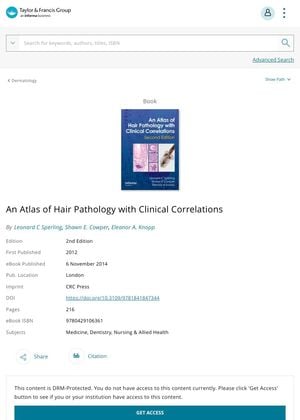TLDR The book helps doctors better understand and treat hair disorders due to gaps in their training.
The document "An Atlas of Hair Pathology with Clinical Correlations" from 2012 highlighted the lack of comprehensive training in diagnosing and treating hair disorders in residency programs. It emphasized that both dermatopathologists and clinical dermatologists often found a gap in their knowledge due to this deficiency. The document served as a new edition of an acclaimed text, aiming to bridge this knowledge gap.
 July 2023 in “Journal of Clinical Medicine”
July 2023 in “Journal of Clinical Medicine” The document concludes that understanding hair follicle histology and the hair cycle is crucial for diagnosing alopecia.
 151 citations
,
August 2010 in “British Journal of Dermatology”
151 citations
,
August 2010 in “British Journal of Dermatology” Guidelines for diagnosing common hair loss include detailed history, clinical examination, and various diagnostic techniques.
 24 citations
,
August 2005 in “The American Journal of Dermatopathology”
24 citations
,
August 2005 in “The American Journal of Dermatopathology” Vertical sections are better than horizontal sections for diagnosing alopecia.
 3 citations
,
January 2018 in “Dermatology”
3 citations
,
January 2018 in “Dermatology” Scalp biopsies help tell apart androgenetic alopecia and alopecia areata.
 29 citations
,
September 2014 in “American Journal of Dermatopathology”
29 citations
,
September 2014 in “American Journal of Dermatopathology” Horizontal sections of scalp biopsies are good for diagnosing Central Centrifugal Cicatricial Alopecia and help customize treatment.







